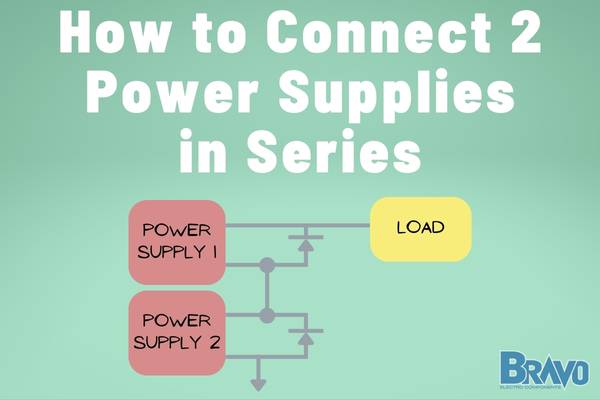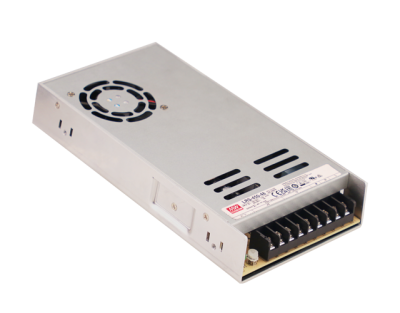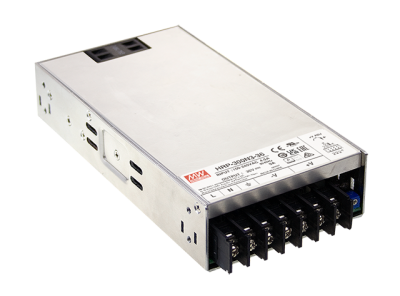
Whether you’re trying to achieve higher supply voltage or simply want to set up redundancy in your system for peace of mind knowing you’re protected from downtime, learning how to connect two DC power supplies in series is a great approach.
But can you put two DC power supplies in series, and is this really the right method for your project? We’ll walk you through all the considerations below to leave you with a clear understanding of your next steps.
If you don’t already have the right DC to DC power supply on hand, look no further than our selection here at Bravo Electro. As a leading MEAN WELL power supply distributor you can rest assured we have the reliable, high-efficiency equipment you need to power your operations with confidence!
For important safety information and our full disclaimer, please click here before proceeding with any of the techniques discussed in this article.
Can You Put Two DC Power Supplies in Series?
First things first, we need to determine if it makes more sense for you to connect your power supply in series vs parallel. So, what does this actually mean, and what are the benefits of this technique?
What Does it Mean to Connect DC Power Supplies in Series?
Connecting DC power supplies in series involves linking the positive terminal of the first power supply to the negative terminal of the second power supply. This setup combines the output voltages of both supplies while keeping the current constant throughout the circuit.
For example, if each power supply outputs 12V and they are connected in series, the total output voltage would be 24V, while the current capacity remains the same as that of the individual supplies. Or instead of using a 48v power supply, you could have four 12v power supplies in series or two 24v power supplies in series.
This method is often used when the required voltage exceeds what a single power supply can provide. You may be wondering…why not just use a 24v power supply instead? That is certainly a viable option, but two power supplies allows for modularity. You can use the 12v power supplies independently when 24V isn't required.
Better yet, connecting power supplies in series allows for redundancy. Having two 12V supplies in series can offer a backup option where one supply might continue to provide power if the other fails, albeit at a lower voltage.
That being said, is connecting two DC power supplies in series the right approach for you?
Is This the Right Approach For Your Project?
Before we get into how to connect two DC power supplies in series it’s important to understand the pros and cons of this configuration. Here are some things to consider:
- Voltage Requirements: If your project needs a higher power supply voltage than a single power supply can offer, series connection is a practical solution.
- Compatibility: Ensure that the power supplies are identical or similar in specifications to prevent imbalances. Using different models can lead to uneven voltage distribution and potential damage.
- Current Needs: Since the current capacity does not increase with series connection, ensure the combined setup meets the current demands of your project.
- Application Type: Series connections are suitable for applications like high-voltage testing, specialized industrial equipment, or certain types of electronics that require higher voltage inputs.
Now - it’s worth noting that you can also connect power supplies in parallel instead. This approach is better suited for applications needing higher current capacity, such as powering multiple devices or heavy-duty equipment simultaneously.
But if after reading all this you determine that connecting your power supplies in series makes the most sense, great - we’ll walk you through the process below to help you set out on the right foot.
How to Connect Two DC Power Supplies in Series: Step-by-Step Guide
Ready to learn how to connect two DC power supplies in series? Before we get into the nitty-gritty details, be aware that this is best left to an experienced electrician if you don’t know what you’re doing or understand the safety side of operating power supplies. Otherwise, here’s an overview of the process:
Gather Necessary Tools and Materials
You’ll obviously need the two DC power supplies you intend to connect in series, but you may need a few other tools and materials as well:
- Wire strippers
- Insulated wires
- Screwdrivers
- Multimeter
- Insulating tape or heat shrink tubing
Ensure that both power supplies are compatible for series connection. They should have similar voltage and current specifications to prevent imbalances. Check the datasheets or manuals of the power supplies for any specific instructions regarding series connections.
Connect the Positive Terminal of the First Power Supply to the Negative Terminal of the Second
Turn off and unplug both power supplies from any power source if necessary. Ensure that the units are placed securely on a stable surface and that there is adequate ventilation around them.
Then, strip the ends and connect the positive terminal of the first power supply to the negative terminal of the second power supply using the insulated wire. Secure the connections using the appropriate screws or terminals. Use insulating tape or heat shrink tubing to cover any exposed wires to prevent short circuits.
Connect the Remaining Terminals to the Load
At this point you can take another piece of insulated wire and connect the free positive terminal of the second power supply to the positive input of your load.
Then, connect the free negative terminal of the first power supply to the negative input of your load. This completes the series connection.
Double-Check Connections and Test the Setup
Carefully inspect all connections to ensure they are secure and correctly oriented. Verify that there are no exposed wires or loose connections that could cause a short circuit.
You should be good to go now, but take the time to test your power supply connections with a multimeter. Turn on the first power supply and then the second power supply. Measure the combined output voltage across the load terminals.
The multimeter should display the sum of the voltages of the two power supplies. If the expected voltage is not achieved, turn off the power supplies immediately and recheck the connections. We have more tips on troubleshooting power supplies in our blog if necessary.
Once you have confirmed the correct voltage, monitor the setup to ensure it operates as expected. If there are any issues, such as unexpected voltage fluctuations or overheating, turn off the power supplies and investigate further.
Otherwise, use cable ties to manage the wires neatly and apply additional insulating tape or heat shrink tubing where necessary to ensure all connections are safe. Pat yourself on the back for a job well done!
Get High-Quality DC Power Supplies at Bravo Electro Today!
There you have it - how to connect two DC power supplies in series. Hopefully, this quick overview has left you with a clear understanding of your next steps. When in doubt, don’t hesitate to reach out to our expert customer service team here at Bravo Electro.
On that note, remember that we’re your one-stop shop for all the different power supply types - including the various types of DC to DC converters.
You can count on us for everything from modular power supply to din rail power supply - we even offer custom power supply solutions if one of our standard offerings doesn’t align with your needs.
All our equipment is sourced from the most trusted manufacturers in the industry, such as MEAN WELL. This means you can shop with peace of mind knowing you’re getting reliable, efficient solutions to support your project.
So, shop today or get in touch for a personalized recommendation. We can get your order shipped out fast so you can put what you’ve learned in this guide into practice and begin powering your projects ASAP!
Final Thoughts on How to Connect Two DC Power Supplies in Series
Connecting two power supplies in series can help you achieve a higher voltage and redundancy in your setup. While it sounds complex, we’ve simplified the process for you above so you can hit the ground running if this configuration makes sense for your unique needs.
Our blog has additional resources on how to convert DC to AC, the difference between AC and DC power supply, how to use DC power supply, how does a DC power supply work, DC DC converter efficiency, DIY AC to DC converter, and more.
But remember - whether you’re looking for the best AC to DC converter or DC-DC power supplies, Bravo Electro has you covered with dependable, high-performance solutions. Get in touch today or shop now for the most trusted power solutions and electrical components the industry has to offer!






